Welcome to our two newest followers Piotr G and ffoster. More particularly for the latter, here is a special post.
A little history
Porsche had already run, through the Martini Racing Team, a turbocharged 911 Carrera RSR that had proved particularly fast during the 1974 season. Customers though had to content themselves with the normally-aspirated Carrera RSR. All that was about to change as for 1976, Porsche unveiled its most important effort in endurance racing since the launch of the 917, releasing both the 936 sportscar and the 935 “silhouette” GT. Both were named after the respective groups in which they would compete, Groups 6 and 5.
Unlike Group 4, which was reserved to traditional GTs, Group 5 allowed major modifications to a car, as long as it kept the overall appearance of the original road-going vehicle. The original 935 still resembled a heavily modified 911, but soon enough Porsche engineers fitted it with the “flat nose” it became famous for. This flat nose not only helped aerodynamics, its main goal was in fact to canalize air streams passing through air intakes in the front spoiler and exiting from vents on the top of each front wings, increasing downforce. Power originally came from a 2.8-litre flat six rated at 560 hp. Performances were incredible… as much as fuel consumption was. Porsche couldn’t know at this point that its two thoroughbreds were embarking on long and successful careers that would last until the FISA would set new rules for endurance racing during the early Eighties.
During the 1976 season, the 935s were only available to the semi-works Martini Racing, and battled all year long against the monstrous (750 hp) but fragile BMW CSL in order to win the world championship. In 1977, the introduction of the 935/77 evolution and the sale of the car to many private teams made things easier for the Stuttgart company, which dominated most events and even had a stint at the 2.0-litre class of the German DTM with a special 935 powered by a 1.4-litre “Baby” engine.
The following season saw the introduction of what is arguably the best remembered 935 of all: the lone 935/78, which thanks to its whale-like silhouette is better known as the “Moby Dick”, from the name of Herman Melville’s famous novel. Engine was enlarged to 3.2-litre, its power now reaching about 750 hp. Designed for high speeds, the Moby Dick had Le Mans as its main objective. Reliability problems slowed the car’s pace, which finished far down the rankings from the victorious Alpine-Renault.
Porsche officially retired for 1979, and its fortune rested in the hands of its customers. These private teams not only received the support of the German company, they could also upgrade their 935s to the K3 version designed by Kremer. Without much opposition from the prototypes, both Porsche, as we have seen, and Renault, which concentrated on Formula One, having retired from the sport, the 935s triumphed at Le Mans – the first ever victory of a GT car there.
From 1980, the Porsche 935 wasn’t as domineering as it used to be. Porsche was about to re-enter endurance racing with a new prototype, the 956 which used a turbocharged 2.6-litre engine derived from the Moby Dick’s block, but neglected its ageing Group 5. Kremer tried to keep the pace with a new K4. It certainly extended the car’s life, but the end was inescapable nonetheless. The last Porsche 935s didn’t retire from racing before 1986, the car’s career thus extending over eleven years.
About the models
Model: Porsche 935 K3
Year: 1979
Event: 1979 Le Mans 24 Hours, driven by Klaus Ludwig, Don Whittington and Bill Whittington (finished 1st overall)
Maker: Ixo
Scale: 1/43
Distributed by: Altaya as no.34 of its Les Plus Belles Voitures des 24 Heures du Mans press series
Acquired: brand new, in February 2005, in Souillac, France
A nice die-cast of the Le Mans-winning 935. Many other scale models of this famous car exist, both as industrial die-casts or resin kits, but for me Ixo’s version looks fine enough on a shelf. My rating is 12/20.
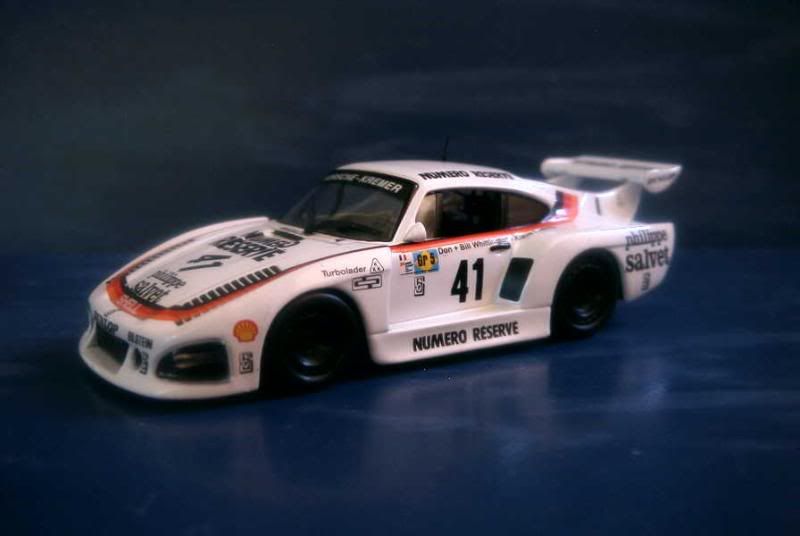


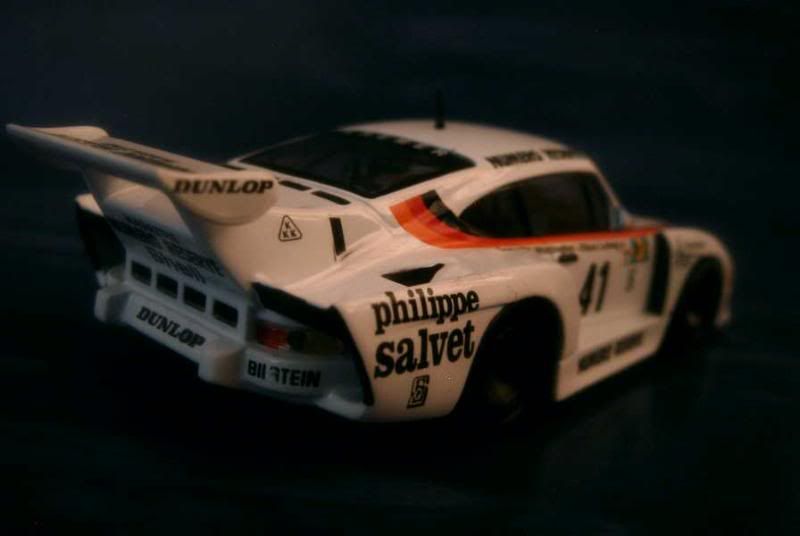
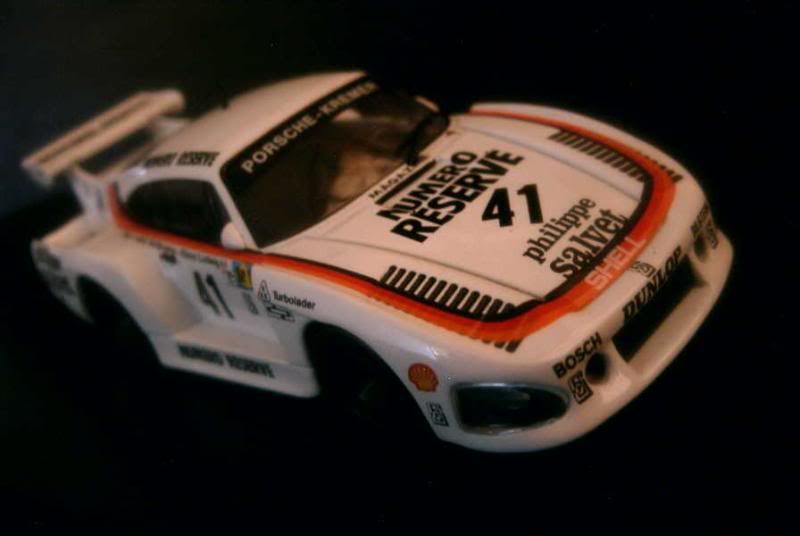
Model: Porsche 935 K3
Year: 1979
Event: 1979 Le Mans 24 Hours, driven by Rolf Stommelen, Paul Newman and Dick Barbour (finished 2nd overall, class winner)
Maker: Ixo
Scale: 1/43
Distributed by: Altaya as no.44 of its Les Monstres Sacrés de l'Endurance press series
Acquired: brand new, in December 2008, in Souillac, France
Just behind the previous car, this 935 finished second. It is best remembered for having been driven by Paul Newman, though some witnesses assure that the actor let most of the job to much more experienced Stommelen and Barbour. Coming from a later Altaya series, this 935 – quite different from the previous model as it was homologated under the IMSA rules – is slightly better detailed, justifying a 13/20 rating.
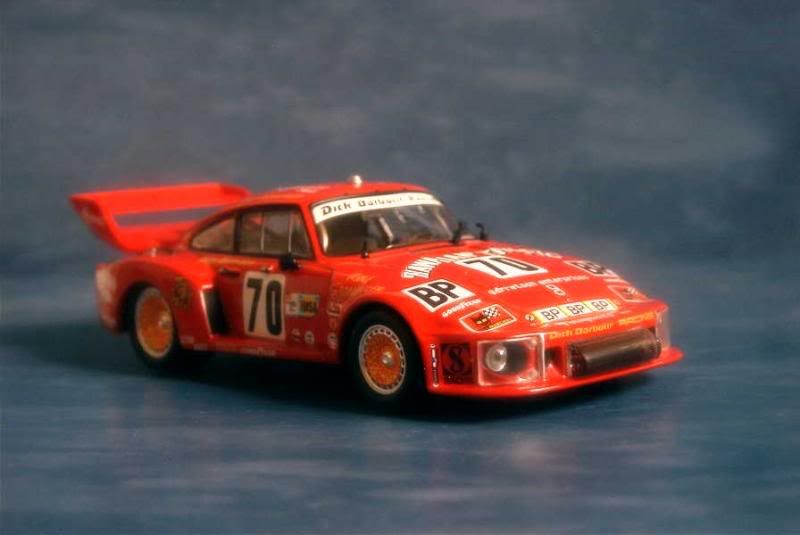
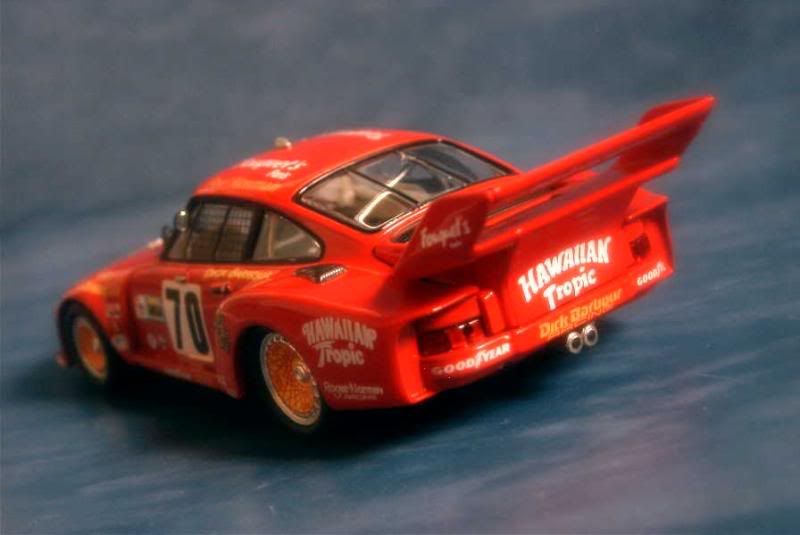
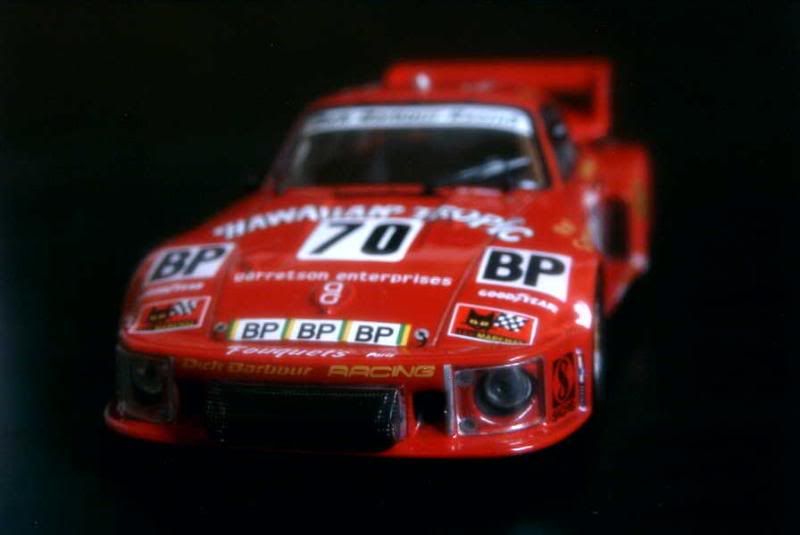
Model: Porsche 935 K3
Year: 1981
Event: 1981 Le Mans 24 Hours, driven by Bob Garretson, Ralph Kent-Cooke and Anny-Charlotte Verney (finished 6th overall)
Maker: Ixo
Scale: 1/43
Distributed by: Altaya as no.55 of its Les Plus Belles Voitures des 24 Heures du Mans press series
Acquired: brand new, in May 2006, in Souillac, France
Basically the same car as the first one presented on this post, but with a different livery to represent a lesser known entry from a later date. My rating is again 12/20.
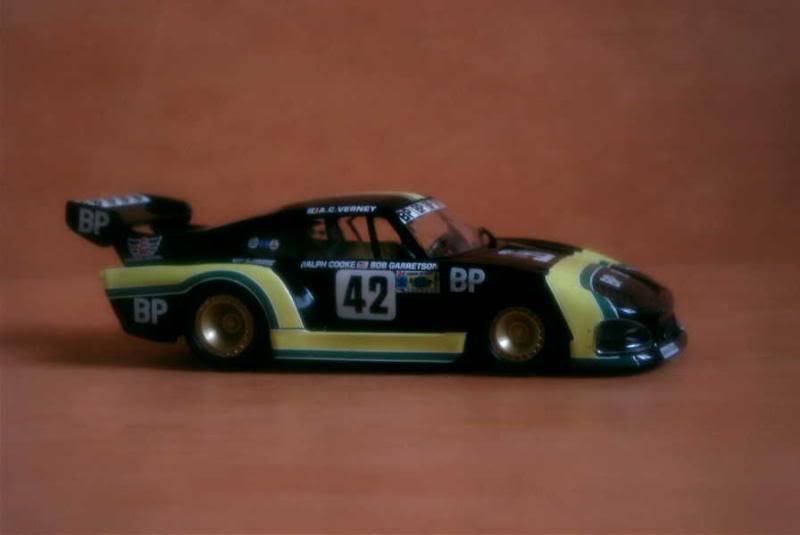
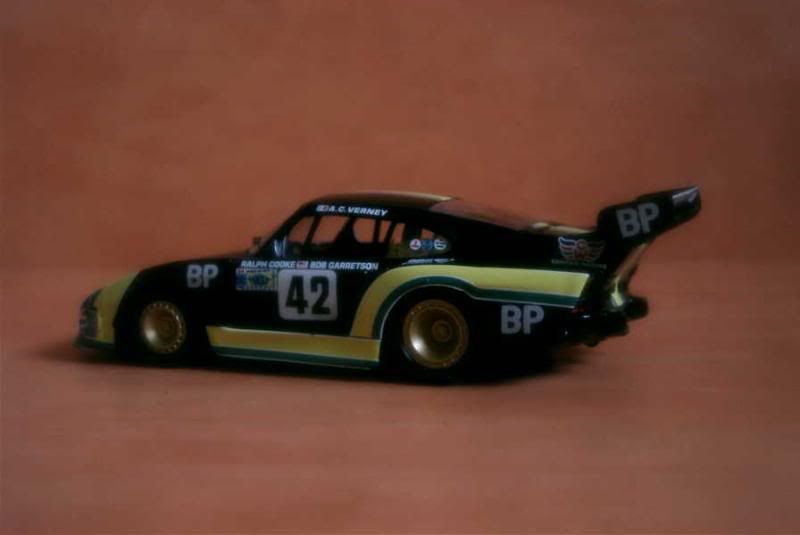
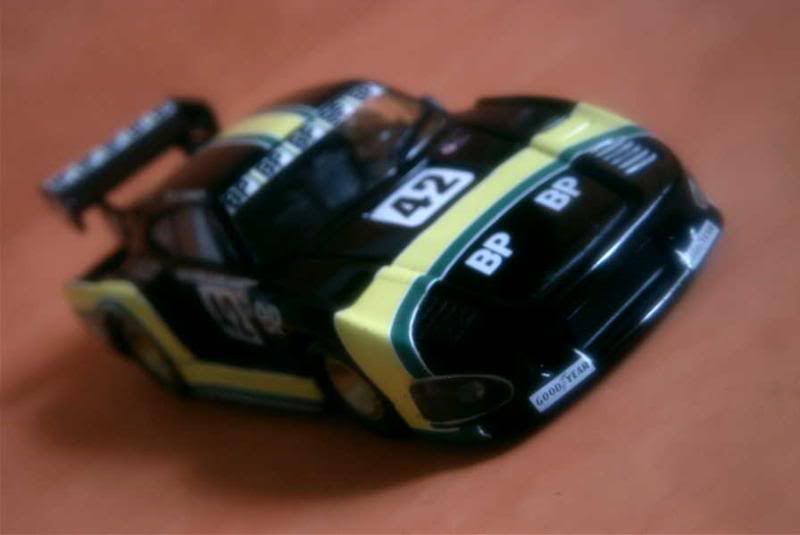
A little history
Porsche had already run, through the Martini Racing Team, a turbocharged 911 Carrera RSR that had proved particularly fast during the 1974 season. Customers though had to content themselves with the normally-aspirated Carrera RSR. All that was about to change as for 1976, Porsche unveiled its most important effort in endurance racing since the launch of the 917, releasing both the 936 sportscar and the 935 “silhouette” GT. Both were named after the respective groups in which they would compete, Groups 6 and 5.
Unlike Group 4, which was reserved to traditional GTs, Group 5 allowed major modifications to a car, as long as it kept the overall appearance of the original road-going vehicle. The original 935 still resembled a heavily modified 911, but soon enough Porsche engineers fitted it with the “flat nose” it became famous for. This flat nose not only helped aerodynamics, its main goal was in fact to canalize air streams passing through air intakes in the front spoiler and exiting from vents on the top of each front wings, increasing downforce. Power originally came from a 2.8-litre flat six rated at 560 hp. Performances were incredible… as much as fuel consumption was. Porsche couldn’t know at this point that its two thoroughbreds were embarking on long and successful careers that would last until the FISA would set new rules for endurance racing during the early Eighties.
During the 1976 season, the 935s were only available to the semi-works Martini Racing, and battled all year long against the monstrous (750 hp) but fragile BMW CSL in order to win the world championship. In 1977, the introduction of the 935/77 evolution and the sale of the car to many private teams made things easier for the Stuttgart company, which dominated most events and even had a stint at the 2.0-litre class of the German DTM with a special 935 powered by a 1.4-litre “Baby” engine.
The following season saw the introduction of what is arguably the best remembered 935 of all: the lone 935/78, which thanks to its whale-like silhouette is better known as the “Moby Dick”, from the name of Herman Melville’s famous novel. Engine was enlarged to 3.2-litre, its power now reaching about 750 hp. Designed for high speeds, the Moby Dick had Le Mans as its main objective. Reliability problems slowed the car’s pace, which finished far down the rankings from the victorious Alpine-Renault.
Porsche officially retired for 1979, and its fortune rested in the hands of its customers. These private teams not only received the support of the German company, they could also upgrade their 935s to the K3 version designed by Kremer. Without much opposition from the prototypes, both Porsche, as we have seen, and Renault, which concentrated on Formula One, having retired from the sport, the 935s triumphed at Le Mans – the first ever victory of a GT car there.
From 1980, the Porsche 935 wasn’t as domineering as it used to be. Porsche was about to re-enter endurance racing with a new prototype, the 956 which used a turbocharged 2.6-litre engine derived from the Moby Dick’s block, but neglected its ageing Group 5. Kremer tried to keep the pace with a new K4. It certainly extended the car’s life, but the end was inescapable nonetheless. The last Porsche 935s didn’t retire from racing before 1986, the car’s career thus extending over eleven years.
About the models
Model: Porsche 935 K3
Year: 1979
Event: 1979 Le Mans 24 Hours, driven by Klaus Ludwig, Don Whittington and Bill Whittington (finished 1st overall)
Maker: Ixo
Scale: 1/43
Distributed by: Altaya as no.34 of its Les Plus Belles Voitures des 24 Heures du Mans press series
Acquired: brand new, in February 2005, in Souillac, France
A nice die-cast of the Le Mans-winning 935. Many other scale models of this famous car exist, both as industrial die-casts or resin kits, but for me Ixo’s version looks fine enough on a shelf. My rating is 12/20.





Model: Porsche 935 K3
Year: 1979
Event: 1979 Le Mans 24 Hours, driven by Rolf Stommelen, Paul Newman and Dick Barbour (finished 2nd overall, class winner)
Maker: Ixo
Scale: 1/43
Distributed by: Altaya as no.44 of its Les Monstres Sacrés de l'Endurance press series
Acquired: brand new, in December 2008, in Souillac, France
Just behind the previous car, this 935 finished second. It is best remembered for having been driven by Paul Newman, though some witnesses assure that the actor let most of the job to much more experienced Stommelen and Barbour. Coming from a later Altaya series, this 935 – quite different from the previous model as it was homologated under the IMSA rules – is slightly better detailed, justifying a 13/20 rating.



Model: Porsche 935 K3
Year: 1981
Event: 1981 Le Mans 24 Hours, driven by Bob Garretson, Ralph Kent-Cooke and Anny-Charlotte Verney (finished 6th overall)
Maker: Ixo
Scale: 1/43
Distributed by: Altaya as no.55 of its Les Plus Belles Voitures des 24 Heures du Mans press series
Acquired: brand new, in May 2006, in Souillac, France
Basically the same car as the first one presented on this post, but with a different livery to represent a lesser known entry from a later date. My rating is again 12/20.






12 comments:
the 935 is one of my favorite racing porsche together with the 917 when I was in my yonger years hehe! somehow i never outgrew this facination to these fine cars, thanks for these excellent pics sir Laurent!
We have published the same post today. I have got the third Porsche too: #42 BP.
Good evening JD, and thank you for your comments.
So you're a 917 fan... I do like it a lot too, along with the 956 - the latter being my own heritage from the "younger years" you mentioned!
:lol: ...sometimes there are funny coincidences!
Though I didn't check this, I believe Altaya didn't release yet its second Le Mans series (for us "Les Monstres de l'Endurance") in Spain?
The first colection was sold in 2005-2006.
The second collection started in 2007 and it is finishing.
Thanks for the info interdomin. Until now it seemed to me only models from the first series were circulating in Spain. Apparently you got them a little while after us, but at least you got them!
yes it was funny that you guys had the same post! :-)
although i couldnt comment on interdomin blog cause i thought he didn't speak english, know i know! :-)
All this happened at the last moment when I saw our friend ffoster's avatar. Initially the topic was to be the Cadillac Eldorado, not exactly the same type of car. It'll be for another time.
I bought my Porsche 935 four years ago. I found the other one (BP #42) in 2007, October at Motorepoca. http://motorepoca.feriavalencia.com/
Thanks for the link interdomin, this is an interesting page about what seems to be a very nice expo. Plus you're saying you can also find model cars there, so that's really heaven!
Gotta' love these 935s, they're legendary and much have been modelled of it. But I can't get enoigh of them. These are no exception.
Great post!
Erwin
Thanks a lot Erwin.
I like the 935 too, though not as much as some other Porsches, perhaps because it unfortunately didn't run during the most interesting years of endurance racing.
Post a Comment